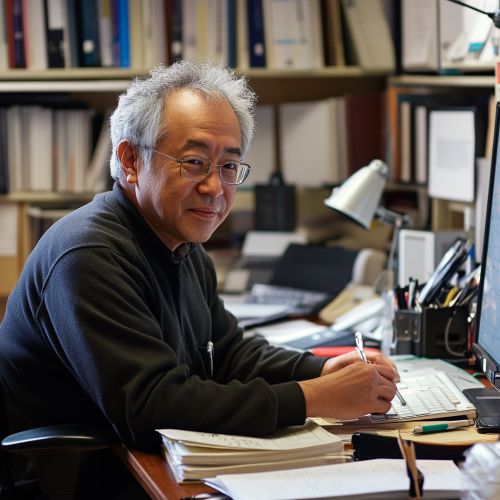Yoichiro Nambu
Early Life and Education
Yoichiro Nambu was born on January 18, 1921, in Tokyo, Japan. He grew up in a period marked by significant political and social changes in Japan, which influenced his early education and intellectual development. Nambu attended the prestigious Tokyo Imperial University, where he studied physics under the guidance of prominent Japanese physicists. He completed his undergraduate degree in 1942 and continued his studies, earning a Ph.D. in physics in 1952.
Academic Career
Nambu's academic career began at Osaka University, where he worked as an assistant professor. His early research focused on quantum field theory and the properties of elementary particles. In 1956, he moved to the United States to join the Institute for Advanced Study in Princeton, New Jersey. This move marked the beginning of a long and fruitful association with American academia.
In 1958, Nambu joined the faculty of the University of Chicago, where he would spend the majority of his career. At Chicago, he held the position of Henry Pratt Judson Distinguished Service Professor Emeritus in the Department of Physics. His work at the University of Chicago was instrumental in shaping the field of theoretical physics.
Contributions to Physics
Spontaneous Symmetry Breaking
One of Nambu's most significant contributions to physics is the concept of spontaneous symmetry breaking. This idea, which he developed in the early 1960s, has become a cornerstone of modern theoretical physics. Spontaneous symmetry breaking occurs when a system that is symmetric under certain transformations chooses a ground state that is not symmetric. This concept has profound implications for the understanding of fundamental forces and particles.
Nambu's work on spontaneous symmetry breaking laid the groundwork for the development of the Higgs mechanism, which explains how particles acquire mass. His insights have had a lasting impact on the field of particle physics and have influenced numerous subsequent discoveries.


Nambu-Goldstone Bosons
In collaboration with Jeffrey Goldstone, Nambu also introduced the concept of Nambu-Goldstone bosons. These are massless scalar particles that arise in theories with spontaneously broken continuous symmetries. The existence of Nambu-Goldstone bosons is a direct consequence of the spontaneous symmetry breaking phenomenon and plays a crucial role in various areas of theoretical physics, including condensed matter physics and quantum field theory.
Quark Model
Nambu made significant contributions to the development of the quark model, which describes the structure of hadrons in terms of more fundamental particles called quarks. His work in this area helped to establish the quark model as a central framework for understanding the behavior of subatomic particles. Nambu's insights into the dynamics of quarks and their interactions have been instrumental in advancing the field of quantum chromodynamics (QCD), the theory that describes the strong interaction.
String Theory
Nambu was also a pioneer in the development of string theory, a theoretical framework that attempts to reconcile general relativity and quantum mechanics. In the late 1960s, he proposed that elementary particles could be modeled as one-dimensional "strings" rather than point-like particles. This idea has since evolved into a major area of research in theoretical physics, with profound implications for our understanding of the fundamental nature of the universe.
Awards and Honors
Throughout his illustrious career, Yoichiro Nambu received numerous awards and honors in recognition of his groundbreaking contributions to physics. Some of the most notable include:
- The Nobel Prize in Physics (2008) for the discovery of the mechanism of spontaneous broken symmetry in subatomic physics.
- The Wolf Prize in Physics (1994) for his contributions to the understanding of the fundamental forces of nature.
- The J. Robert Oppenheimer Memorial Prize (1976) for his work on spontaneous symmetry breaking and the quark model.
- The National Medal of Science (1982) for his contributions to theoretical physics.
Legacy
Yoichiro Nambu's work has left an indelible mark on the field of theoretical physics. His pioneering ideas and innovative approaches have influenced generations of physicists and have shaped our understanding of the fundamental forces and particles that make up the universe. Nambu's legacy continues to inspire new research and discoveries in the field of physics.
Personal Life
Nambu was known for his modesty and dedication to his work. Despite his numerous accolades, he remained humble and focused on his research. He was also a mentor to many young physicists, guiding them in their own scientific pursuits. Nambu passed away on July 5, 2015, leaving behind a rich legacy of scientific achievement.
See Also
- Spontaneous Symmetry Breaking
- Higgs Mechanism
- Nambu-Goldstone Boson
- Quark Model
- String Theory
- Quantum Chromodynamics
- General Relativity
- Quantum Mechanics
